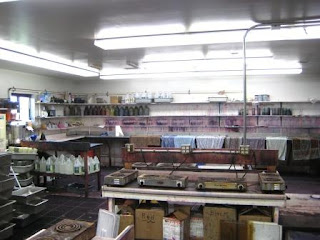We all know by now that we need to keep an eye on our stitch gauge. The number of stitches per inch is how we know whether a piece will be the size we were aiming for: too few and it's too big, and too many and it's too small. But what about row gauge?
This is not the time to get faint of heart. Row gauge is important for many types of patterns, and nearly always for vertical patterns. Colorwork only works in exact numbers of rows (not "knit 4 inches"), and if your row gauge is off, your piece will be too long or too short. Shapes that were intended to be circles become ovals, squares become rectangles, and the pattern becomes a funhouse mirror version of the original. Knowing your row gauge makes several things easier.

The socks at left were knit and posted on Ravelry by Stacey14, from a pattern by Priscilla Gibson-Roberts in her book,
Ethnic Socks and Stockings. There are several patterns here, some running vertically and some horizontally. If you need to shorten or lengthen a vertical repeat, what do you do? Maybe you want a shorter version of this sock. Now what?
Well, you need to do your math. (This is why the Lord created calculators and scrap paper!) If the total pattern repeat is designed to be 1 3/4 inches tall, and you want a shorter sock, no problem. First, knit a swatch including two pattern repeats. Measure your row gauge. Does it match the pattern? If yes, cool. You'll want to decrease in whole repeats to maintain the look, so you'll decrease the finished size by increments of 1 3/4 inches. If the total sock has a 12 inch leg, with each full pattern repeat you take out, you subtract 1 3/4 inches. Originally there were 6 repeats + cuff = 7 units of height. Don't take off the cuff - it anchors the look. Remove one or more of the leg motif repeats.
Total length in inches - (number of repeats x 1.75 inches) = new total length.
But what if your row gauge doesn't match the pattern? Well, there are two ways to go - try to get the row gauge, or live with your unique gauge. I tend to go with the one that matches the pattern, because it retains the original shapes in the design. If your stitches are right on, and rows are off, you have the right needle size, but not the right material. Too few rows mean you need stickier needles (bamboo like Clover, or non-slippery plastic, like Denise) and too many rows mean you need slippery needles (Addi's or Boye.) If this works, you're all set to move on.
If you're already using the recommended needle material, it's probably you. Maybe you knit a little tightly, or a little loosely by nature. No worries. Stick with your unique gauge. Then to get the dimensions in the pattern, you may need to knit more or fewer total rows. If you're knitting at 1 1/2 inches per pattern repeat, you'll need to do 7 repeats + cuff = 8 total to make it the length specified in the pattern. The design will look like a shorter, fatter version of the original, and if you like it, go with it. (If not, pick a new pattern!)
(Total length) 12 / 1.5 (height of repeat) = 8
Wouldn't it be cool if it all worked out that way? Well, it usually does. But sometimes you want your garment to be longer or shorter in an increment different from the repeat. If you have a 2 3/4 inch repeat and you only need 4 more inches, you won't be able to work in full pattern repeats and still get the measurements you want. That means you either pick a different pattern, or you live with a partial repeat somewhere. Put the partial repeat in the less visible part of the garment, usually the bottom. You'll do your regular math of
Row gauge x total desired length = total number of rows - then -
Total # of rows / number of rows in one repeat = number of repeats, with the remainder being the number of extra rows
If you need to do a partial repeat at the bottom, you'll want to work the top part of the pattern in the extra rows. If you need to do a partial repeat at the top, do the bottom part of the pattern.
You can do this. Get some coffee or tea, and your scrap paper and calculator, and do the math first. Sketch it on some graph paper to make sure it makes sense. Write out your new directions as thoroughly as possible so you don't have to do the work again. Then, get knitting!












